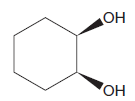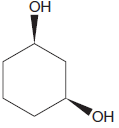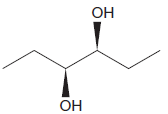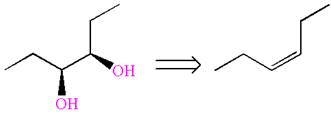
(a)
Interpretation:
Whether the given
Concept introduction:
The alkene, on reaction with
Answer to Problem 24.19P
The given diol is

Explanation of Solution
The given diol is

The given diol is

It is determined that the diol can be produced using reagents, either
(b)
Interpretation:
Whether the given diol can be produced from an alkene using either
Concept introduction:
The alkene, on reaction with
Answer to Problem 24.19P
The given diol is not a
Explanation of Solution
The given diol is

The given diol is not a
It is determined that the diol cannot be produced using reagents either
(c)
Interpretation:
Whether the given diol can be produced from an alkene using either
Concept introduction:
The alkene, on reaction with
Answer to Problem 24.19P
The given diol is not a
Explanation of Solution
The given diol is

The given diol is not a
It is determined that the diol cannot be produced using reagents either
(d)
Interpretation:
Whether the given diol can be produced from an alkene using either
Concept introduction:
The alkene, on reaction with
Answer to Problem 24.19P
The given diol is

Explanation of Solution
The given diol is

The given diol is

It is determined that the diol can be produced using reagents either
(e)
Interpretation:
Whether the given diol can be produced from an alkene using either
Concept introduction:
The alkene, on reaction with
Answer to Problem 24.19P
The given diol is

Explanation of Solution
The given diol is

The given diol is

The alkene that can be used to produce this diol is identified by replacing the hydroxyl groups and placing the double bond between those carbons. Therefore, the structure of the alkene is

It is determined that the diol can be produced using reagents either
Want to see more full solutions like this?
Chapter 24 Solutions
ORGANIC CHEMISTRY E-BOOK W/SMARTWORK5
 ChemistryChemistryISBN:9781305957404Author:Steven S. Zumdahl, Susan A. Zumdahl, Donald J. DeCostePublisher:Cengage Learning
ChemistryChemistryISBN:9781305957404Author:Steven S. Zumdahl, Susan A. Zumdahl, Donald J. DeCostePublisher:Cengage Learning ChemistryChemistryISBN:9781259911156Author:Raymond Chang Dr., Jason Overby ProfessorPublisher:McGraw-Hill Education
ChemistryChemistryISBN:9781259911156Author:Raymond Chang Dr., Jason Overby ProfessorPublisher:McGraw-Hill Education Principles of Instrumental AnalysisChemistryISBN:9781305577213Author:Douglas A. Skoog, F. James Holler, Stanley R. CrouchPublisher:Cengage Learning
Principles of Instrumental AnalysisChemistryISBN:9781305577213Author:Douglas A. Skoog, F. James Holler, Stanley R. CrouchPublisher:Cengage Learning Organic ChemistryChemistryISBN:9780078021558Author:Janice Gorzynski Smith Dr.Publisher:McGraw-Hill Education
Organic ChemistryChemistryISBN:9780078021558Author:Janice Gorzynski Smith Dr.Publisher:McGraw-Hill Education Chemistry: Principles and ReactionsChemistryISBN:9781305079373Author:William L. Masterton, Cecile N. HurleyPublisher:Cengage Learning
Chemistry: Principles and ReactionsChemistryISBN:9781305079373Author:William L. Masterton, Cecile N. HurleyPublisher:Cengage Learning Elementary Principles of Chemical Processes, Bind...ChemistryISBN:9781118431221Author:Richard M. Felder, Ronald W. Rousseau, Lisa G. BullardPublisher:WILEY
Elementary Principles of Chemical Processes, Bind...ChemistryISBN:9781118431221Author:Richard M. Felder, Ronald W. Rousseau, Lisa G. BullardPublisher:WILEY





